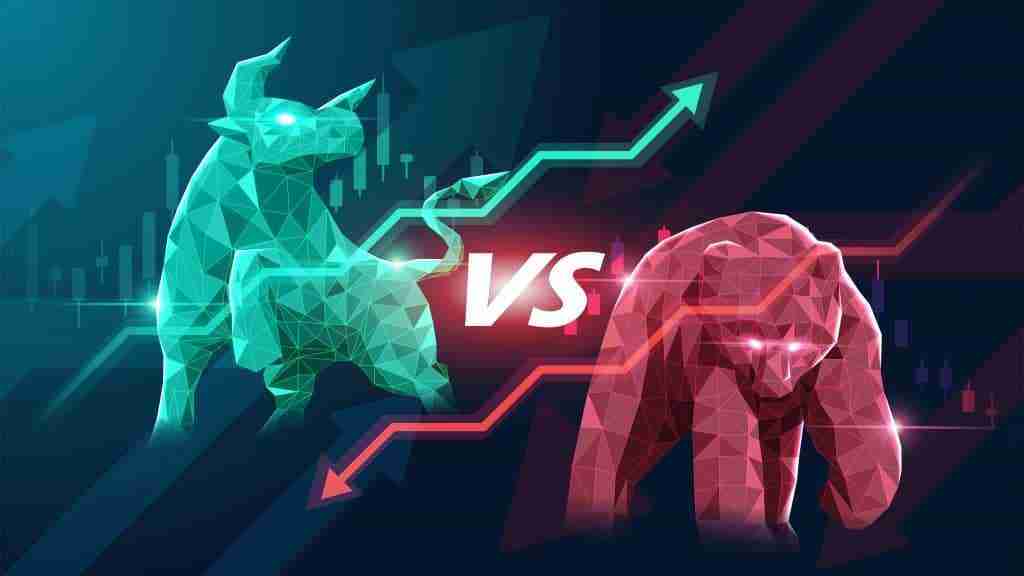
Bullish and Bearish are standard terms used in the investing lexicon. If you want to become an investor, you must understand basic investment terms. You may have heard these terms used while listening to CNBC or reading the Wall Street Journal.
But what exactly does being “bullish” and “bearish” mean, and where did those terms come from?
Let’s look at the definition of bullish vs. bearish and the history of the two terms.
What Does It Mean To Be Bullish?
When someone says they are Bullish, they believe an individual stock, industry sector, or the overall market will go up in value.
When one refers to the stock market, they most likely refer to the S&P 500, a weighted average of the 500 largest publicly traded companies by market capitalization.
You can be Bullish on a stock or the overall market for several reasons including, but not limited to:
- Strong earnings of the individual company, industry, sector, or overall stock market
- An excellent business strategy that will put the company in a competitive advantage
- Advantageous economic data (low unemployment, inflation, increased Gross Domestic Product, increased retail sales, increased durable goods orders)
- Introduction of new technology
- Increased production capacity
- Decreased production costs
Someone might say “I am Bullish about Tesla because they are releasing a new car this year.”
What Does It Mean To Be Bearish?
When someone says they are Bearish, they believe an individual stock, industry sector, or the stock market, in general, will go down in value. A bear market occurs when the stock market drops 20% or more.
The reasons for being bearish can include, but are not limited to:
- Weak earnings of the individual company or overall market
- A poor business strategy that will put the company in a competitive advantage
- Unfavorable economic data (high unemployment, inflation, decreased Gross Domestic Product, decreased retail sales, reduced durable goods orders)
- Decreased production capacity
- Increased production costs
A person might say “I Bearish on the market because unmployment and inflation are abnormally high.”
Where Did The Term Bullish Come From?
The etymology of the term bullish is unclear. However, most people lend meaning to the way a bull attacks.
- The term Bullish comes from a bull’s method of attack. When a bull attacks, it moves its horns upward, analogous to the stock market going up in value.
Analysts often consider it a bull market if there is a 20% or more rise from the stock market’s most recent low.
Did you know?
The longest bull market in history lasted 11 years, began in March 2009, and ended in March 2020, when the S&P 500 rose nearly 460%.
Where Did The Term Bearish Come From?

There are two theories regarding the genesis of the usage of the term Bearish.
- Like a bull, the term bearish is derived from a bear’s method of attack. When a bear attacks, it paws down, analogous to the stock market moving downward or losing value.
- The second theory is that the term comes from a proverbial expression “selling the bear’s skin before one has caught the bear.” Meaning if everyone is selling, the prices will go down in value.
Conversely, analysts consider it a bear market if there is a 20% or more decrease from the most recent stock market high.
The longest bear market in history lasted about 5 years and ended in March 1942, when the S&P 500 lost about 50% of its value.
In 2008, many investors were bearish on the housing market as the economy teetered on the brink of financial disaster.
Is It Better To Be Bullish or Bearish?
Most investors are bullish over the long term, meaning they want the stock market to increase value.
There are sophisticated investors such as hedge funds and institutional investors that made fortunes by taking advantage of bear markets through short selling.
For example, hedge-funder John Paulson bet against the housing market during the 2008 financial crisis by shorting mortgage-backed securities.
Paulson’s strategy netted $15 billion and made him a hedge fund superstar.
There are numerous strategies to take advantage of bull and bear markets. However, trying to time the market is often incredibly difficult for individual investors and is best left to professional investors.
How To Make Money In Each Type of Market
It is certainly possible to make money in both bullish and bearish markets. While no strategy guarantees success, below are some common strategies deployed for each kind of market.
Strategies deployed in a Bear Market
- Shorting Stocks or Market Indexes
- Selling Covered Call Options to generate income
- Buying Put Options to hedge downside risk
- Buying stocks that are on sale
Strategies deployed in a Bull Market
- Selling Put Options for income generation
- Buying Call Options to take advantage of increasing stock prices
If you are unfamiliar with the financial markets, it may be best to stick to a long-term investing strategy and ignore the ups and downs.
The Bottom Line
Gaining a better understanding of the difference between bullish vs. bearish and familiarizing yourself with investing lexicon, in general, will allow you to digest financial news more quickly.
There have been bull markets and bear markets caused by different economic, social, and medical-related factors throughout history.
The most recent Bear Market occurred in March 2020 when the S&P 500 dropped about 35% as the COVID outbreak took hold and sent fear rippling through the stock market and world.
Those fears quickly resided, and stock markets are now reaching record levels.
That said, as an individual investor, it’s best not to panic buy or sell. Individual investors should maintain a well-diversified portfolio to be prepared to weather all market conditions.

